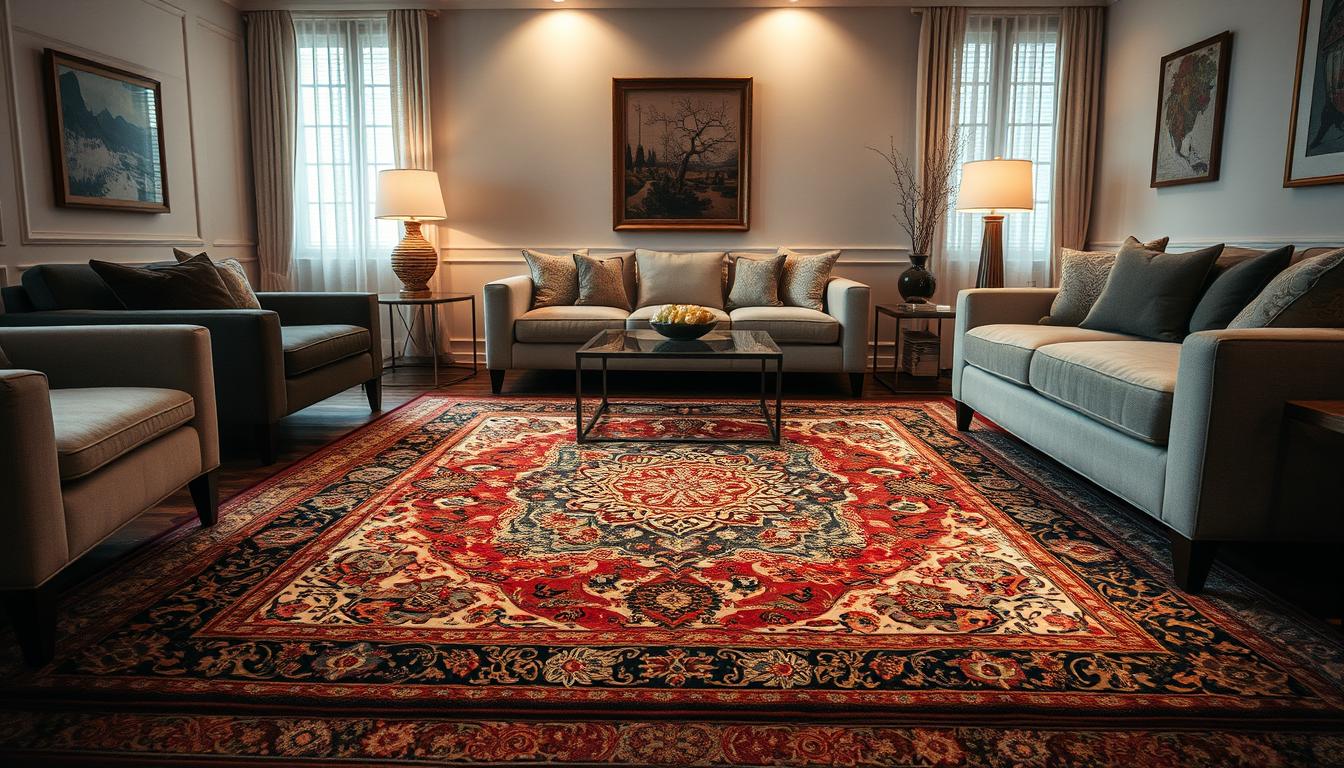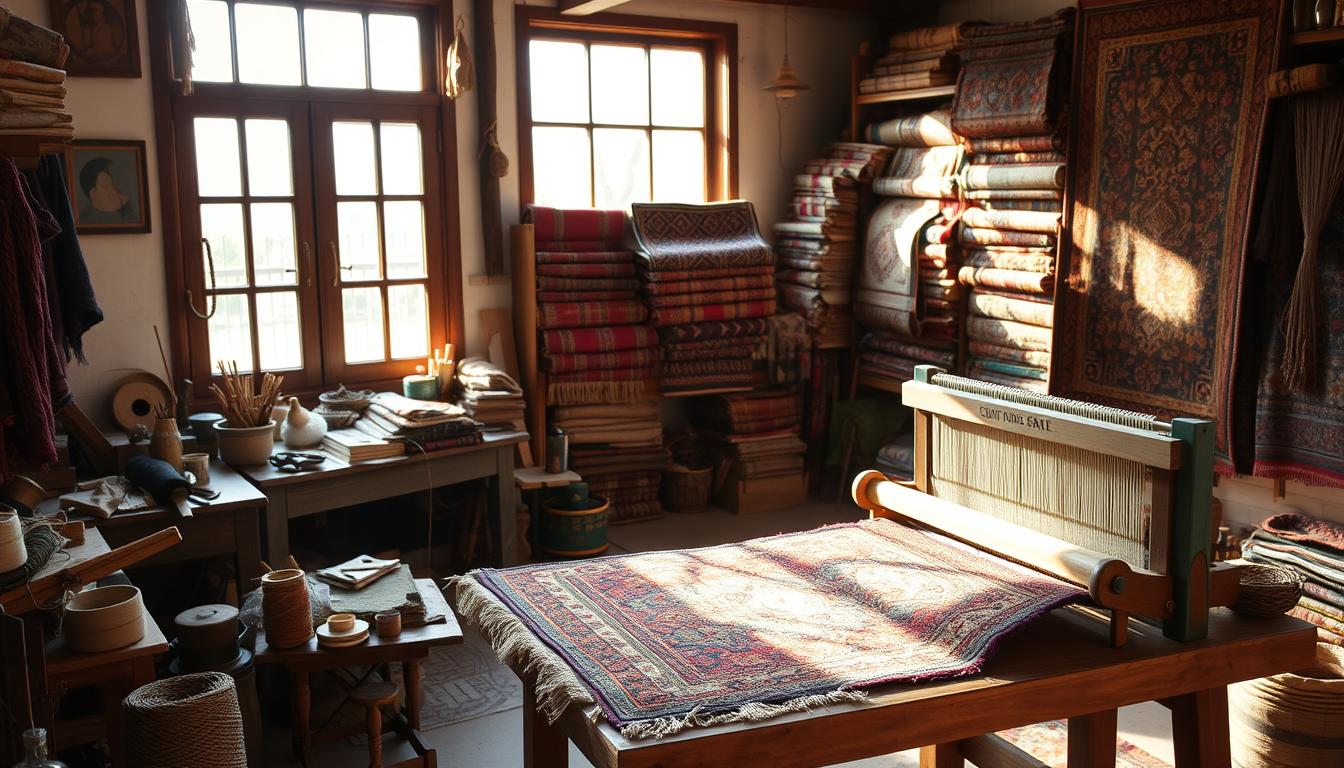
Oriental Rug Care: 6 Essential Tips to Protect Its Beauty

These intricate handmade pieces can last generations—but only if you avoid common mistakes. While some assume frequent deep cleaning preserves their value, improper techniques often cause irreversible damage. The truth? Your approach determines whether that vibrant pattern fades in 5 years or shines for 50.
Understanding your textile’s unique needs isn’t just about aesthetics. Many heirlooms carry cultural stories woven into their fibers. A single misstep in maintenance could erase centuries of craftsmanship. Yet with the right strategies, you’ll protect both its beauty and historical significance effortlessly.
Key Takeaways
- Proper maintenance can extend a textile’s lifespan from decades to centuries
- Mismatched cleaning methods often cause more harm than dirt itself
- Material composition dictates care requirements (wool vs. silk vs. synthetic blends)
- Daily habits impact longevity more than annual professional treatments
- Environmental factors like humidity require proactive adjustments
- Spot-cleaning mastery prevents small stains from becoming permanent flaws
Ready to transform how you preserve these artistic investments? The following insights reveal why most owners underestimate their role in safeguarding handmade floor coverings—and how you can become the exception.
Introduction to Oriental Rug Care
Your home's air quality and your textile's longevity share an unexpected connection. These floor coverings work like silent guardians, capturing particles you’d never notice—until neglect turns them into threats.
Why Proper Maintenance Is Essential
Every fiber acts as a microscopic net. Dust mites, cooking fumes, and pet dander settle deep within the weave. Over time, these invaders break down materials, causing colors to dull and threads to weaken.
Left unchecked, debris becomes abrasive. It grinds against delicate knots during foot traffic, accelerating wear. “What you don’t remove today becomes tomorrow’s irreversible damage,” explains a textile preservation expert.
How This Guide Helps You Preserve Your Investment
Consistency beats occasional deep cleans. Simple routines—like strategic vacuuming—prevent 80% of common issues. Our methods align with museum conservation standards, adapted for home use.
You’ll learn when DIY solutions work and when to call professionals. For instance, our cleaning guide reveals safe stain removal techniques that won’t void warranties. Proper care transforms decades into centuries of use, letting future generations admire the craftsmanship.
Understanding Oriental and Persian Rugs
The threads beneath your feet tell stories older than modern nations. To protect these woven narratives, you must first recognize what makes each textile unique. Origin determines everything—from dye formulas to knot density—and shapes your maintenance strategy.

Geography Defines Craftsmanship
Textiles labeled "Oriental" come from Asia and the Middle East, while "Persian" specifically refers to Iranian creations. This distinction matters because regional traditions dictate material choices. For example, pieces from mountainous areas often use thicker wool for insulation.
| Feature | Oriental | Persian |
|---|---|---|
| Primary Regions | China, India, Turkey | Iran, Caucasus |
| Common Materials | Wool, silk, bamboo | Hand-spun wool, cotton |
| Knot Density | 80-200 per sq inch | 300-800 per sq inch |
Stories Woven in Thread
Many patterns symbolize ancient beliefs or historical events. A Turkmen design might represent tribal identity, while Persian motifs often depict poetry. "These aren't floor coverings—they're cultural archives," notes textile historian Amir Vaziri.
Natural dyes react unpredictably to harsh chemicals, which explains why professional services are mandatory for silk pieces. Your vacuum’s beater bar could unravel months of handiwork in seconds. Matching methods to materials preserves both beauty and heritage.
Evaluating Your Rug's Condition for Optimal Care
Your floor covering’s longevity depends on accurate condition assessment before any maintenance begins. Start by identifying its material composition—this determines every cleaning decision you’ll make.
Assessing Material, Age, and Wear
Natural fibers demand specific handling. Wool reacts poorly to heat, while silk disintegrates under harsh chemicals. Check these markers:
| Material Type | Risk Factors | Safe Cleaning Methods |
|---|---|---|
| Wool/Cotton | Shrinkage, dye bleeding | Cold water, pH-neutral solutions |
| Silk | Fiber breakdown | Dry foam extraction |
| Synthetic | Chemical damage | Low-moisture techniques |
Inspect for loose threads or color shifts in high-traffic zones. Test cleaning products on hidden corners first—some dyes fade instantly. "Age weakens fibers like time rusts iron," warns textile conservator Lila Chen.
Cold water preserves wool’s structure during washing. For detailed methods, consult our step-by-step maintenance guide. Proper evaluation prevents 73% of common restoration issues according to recent preservation studies.
Regular Maintenance: Vacuuming and Dust Removal
The secret to preserving your textile's vibrancy lies in how you handle everyday particles. While intricate patterns hide surface dust, microscopic grit works like sandpaper on delicate threads. Strategic cleaning stops wear before it starts.

Vacuuming Best Practices for Delicate Fibers
Flip your floor covering every cleaning session. The backing traps 60% more debris than the top layer according to textile studies. Use a beater brush here—its agitation loosens embedded grime without harming the dense underside.
| Surface | Tool | Frequency |
|---|---|---|
| Backing | Beater brush | Weekly |
| Front (short pile) | Suction-only | 2-3x weekly |
| Fringes/Long pile | Handheld nozzle | As needed |
Switch to suction mode for the visible side. Rotating brushes unravel knots in silk blends. "Treat handcrafted pieces like museum artifacts—gentle precision beats brute force," advises preservation specialist Mara Jenson.
Tips to Keep Dust and Debris at Bay
Focus on entryways and seating areas where foot traffic concentrates. Lift rather than drag your nozzle over worn sections. For heirloom pieces, wrap the vacuum head in cheesecloth to catch loose threads.
Consistency matters more than intensity. Two brief weekly sessions prevent dirt from compacting into fibers. This routine also disrupts moth life cycles—eggs can’t hatch if you remove them within 7 days.
Effective Spot Cleaning Techniques
Accidents strike when least expected, but your quick response determines whether they leave lasting marks. Immediate action preserves both the appearance and structural integrity of delicate textiles.
Steps to Tackle Immediate Stains
Blot—don’t scrub—the moment liquid hits fibers. Use a white cotton cloth to absorb spills from edges inward. Colored towels risk dye transfer, while paper products leave lint residue.
For stubborn marks, apply solutions strategically:
- Club soda lifts wine and coffee
- Baking soda paste absorbs oil
- White vinegar neutralizes pet odors
Test cleaners on hidden areas first. Silk and wool react differently—a pH-neutral detergent works best for protein-based stains. "Time is your enemy in stain removal," notes textile conservator Elena Torres. Repeat blotting until no residue transfers, then air-dry completely.
Persistent issues? Book a professional cleaning service before stains set permanently. Proper technique today prevents costly restoration tomorrow.
Deep Cleaning Methods for a Uniform Look
Maintaining consistent color and texture requires more than spot treatments. Over time, partial cleaning creates visible contrasts between treated and untreated areas. A full-surface approach ensures every fiber reflects light equally.
Using a Sponge and Mild Detergents
Mix ¼ cup gentle detergent with room-temperature water in a small bucket. Cold liquids prevent wool shrinkage, while warm solutions risk loosening knots. Dip a clean sponge into the mixture, wringing out excess moisture.
Work in grid sections, following the weave pattern. This method prevents missed spots and uneven pressure. Rinse your sponge frequently—dirty water reintroduces grime to cleaned areas.
After completing the surface, blot with dry towels. Never scrub—friction distorts fibers. For detailed guidance, follow our step-by-step process designed for handmade textiles.
Air-dry flat away from sunlight to prevent color fading. Rotate the piece every hour for even drying. Deep clean every 12-18 months unless stains demand immediate attention.
FAQ
How often should I deep clean my delicate fibers?
Aim for a thorough cleaning once a year. If your decor piece sees heavy foot traffic or pets, consider every 6–8 months. Always use mild solutions or hire certified professionals to avoid damaging dyes or textures.
Can I use regular carpet cleaners on antique designs?
Avoid harsh chemicals or machines designed for wall-to-wall carpets. Older textiles often require gentler methods, like handwashing with pH-neutral detergents. Test any product on a hidden corner first.
What’s the safest way to remove fresh spills?
Blot—don’t rub—the spot immediately with a clean cloth. Use cold water and a dab of mild soap for most stains. For tougher issues like wine or ink, consult a specialist to prevent color bleeding.
Does sunlight harm intricate patterns over time?
Yes. Prolonged exposure fades vibrant dyes. Rotate your decor periodically and use UV-filtering window treatments to protect high-value pieces displayed in sunny rooms.
How do I prevent fraying edges or loose threads?
A> Keep beater bars off fringes during vacuuming. For minor damage, trim loose threads carefully with sharp scissors. Major repairs should be handled by experts to maintain structural integrity.
Why does my decor item smell musty after storage?
Trapped moisture encourages mold growth. Before storing, ensure it’s fully dry and wrap it in breathable cotton—never plastic. Add cedar blocks to deter pests without harsh chemicals.









